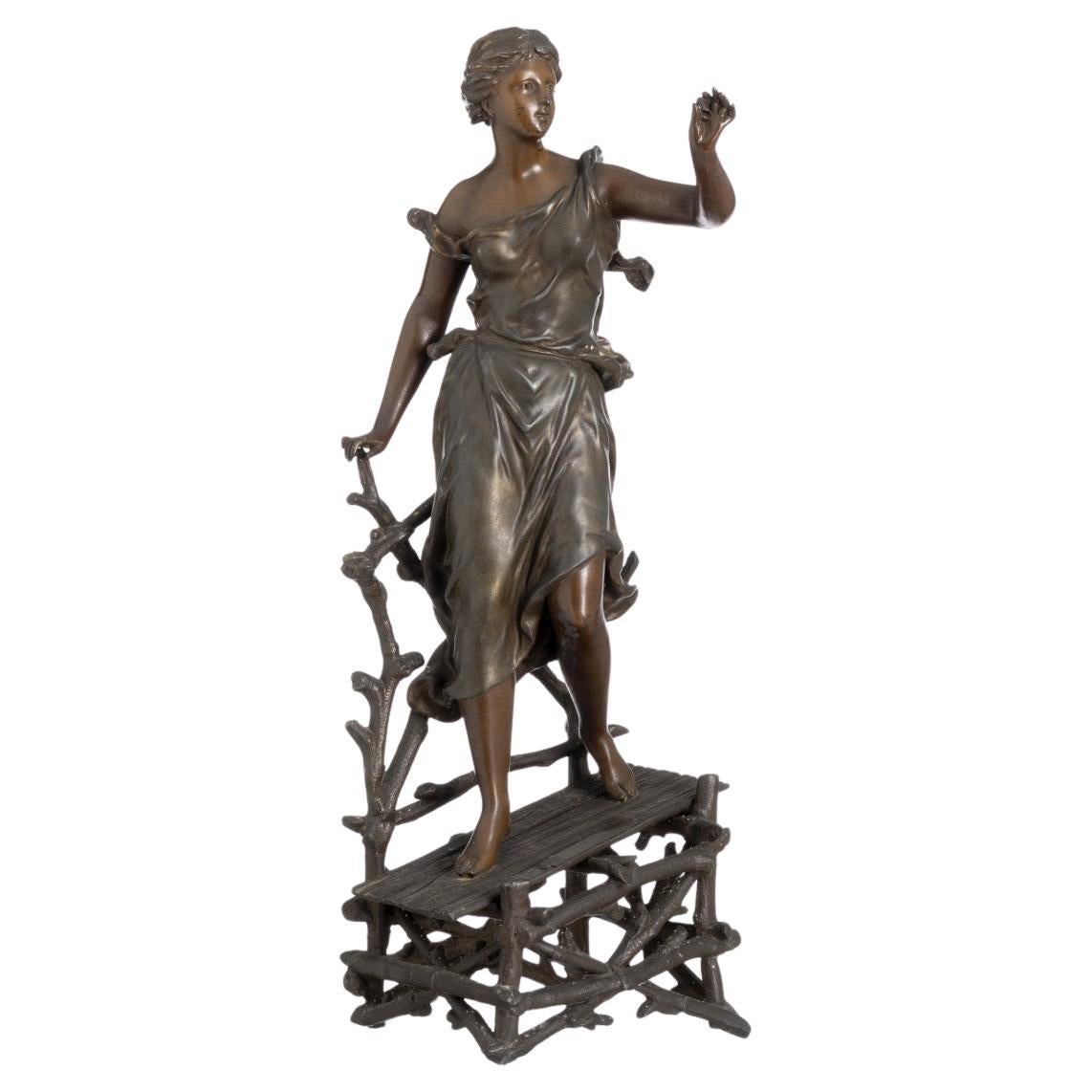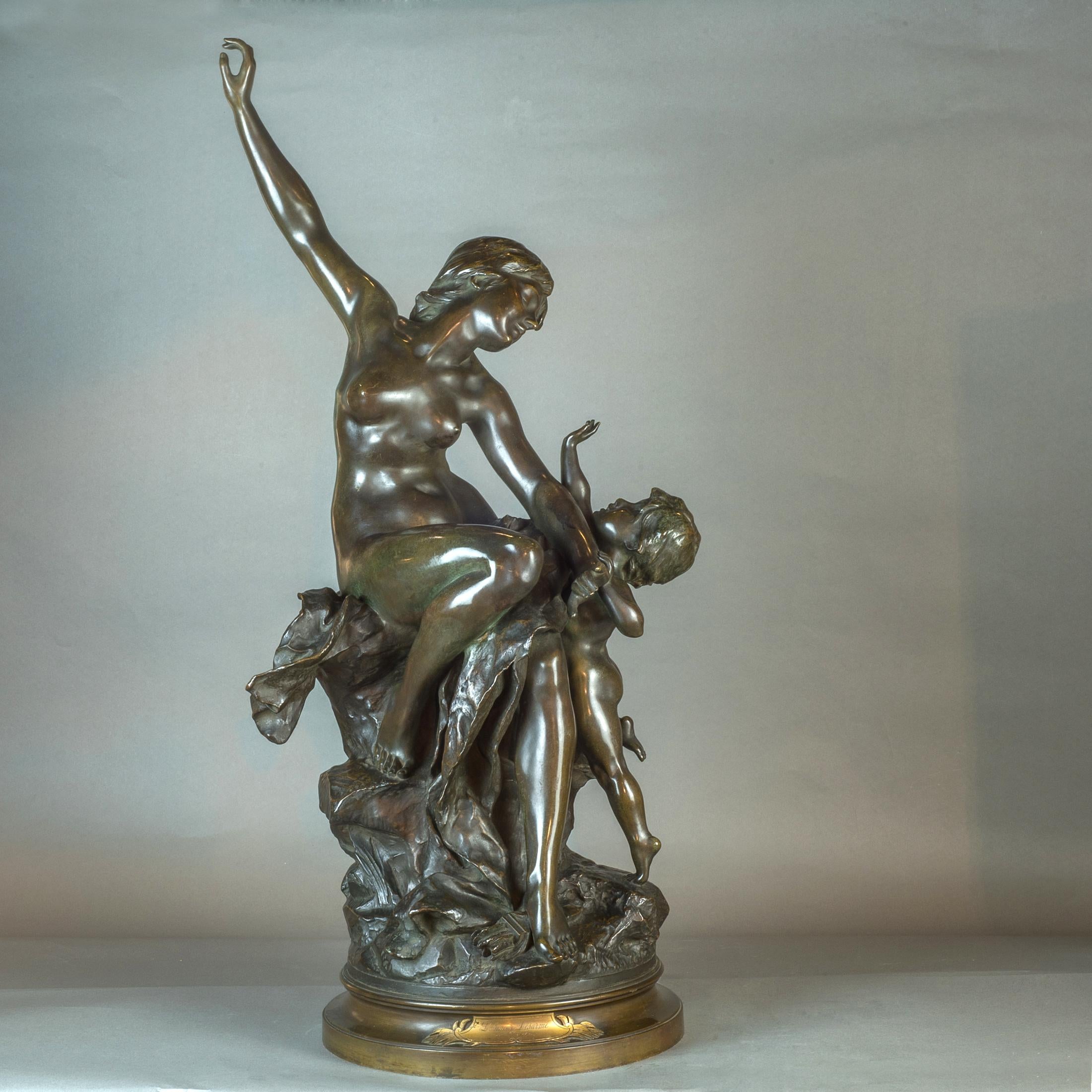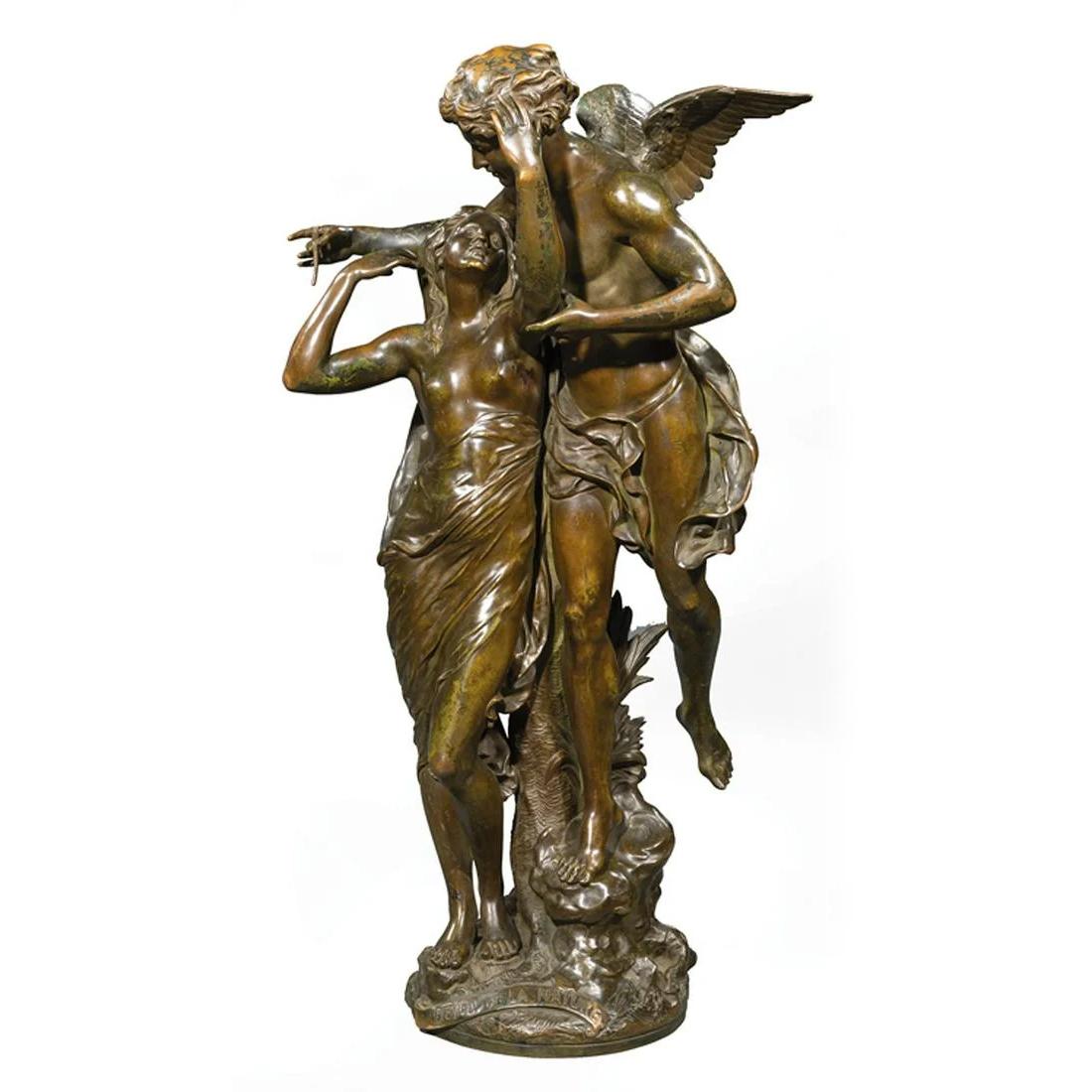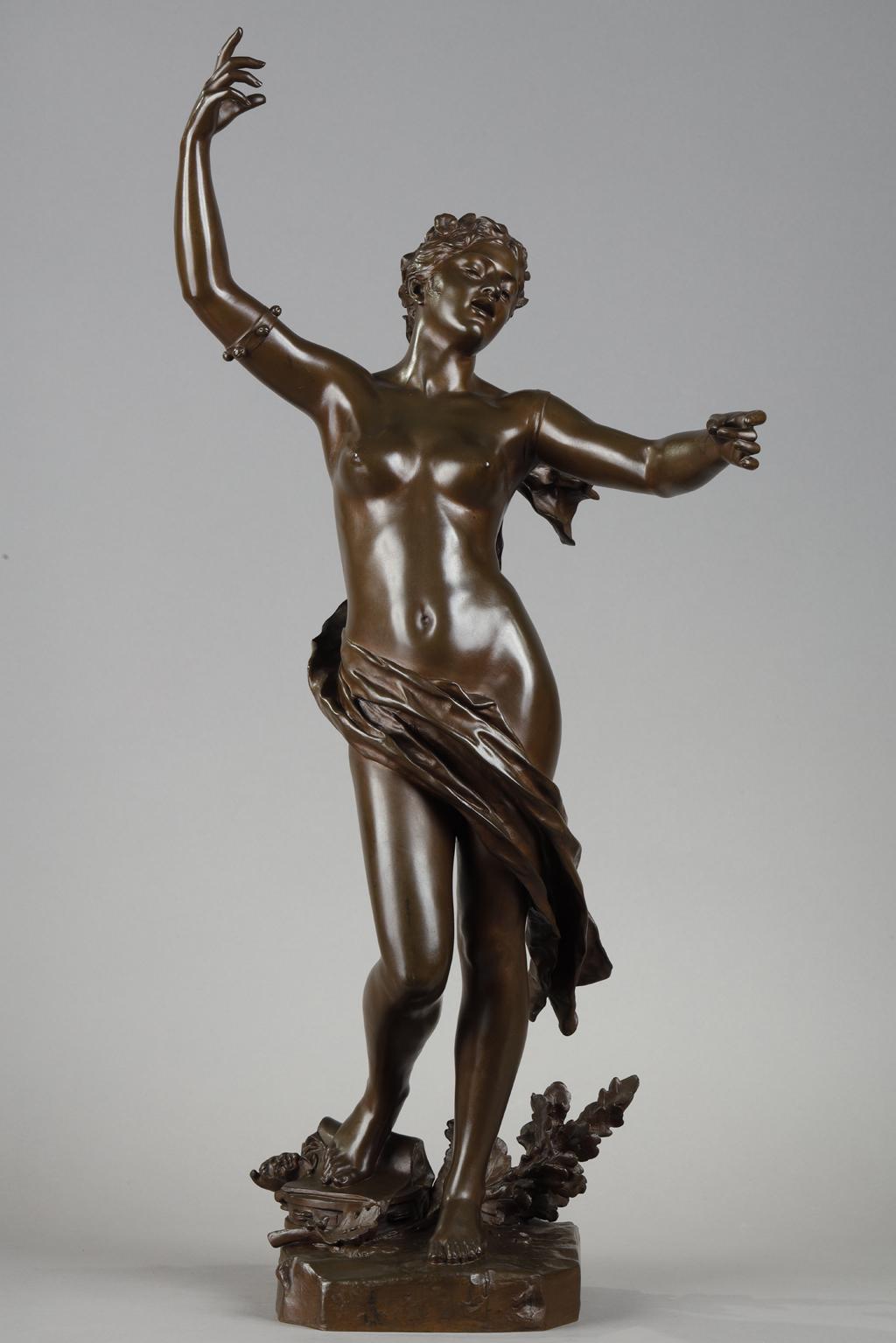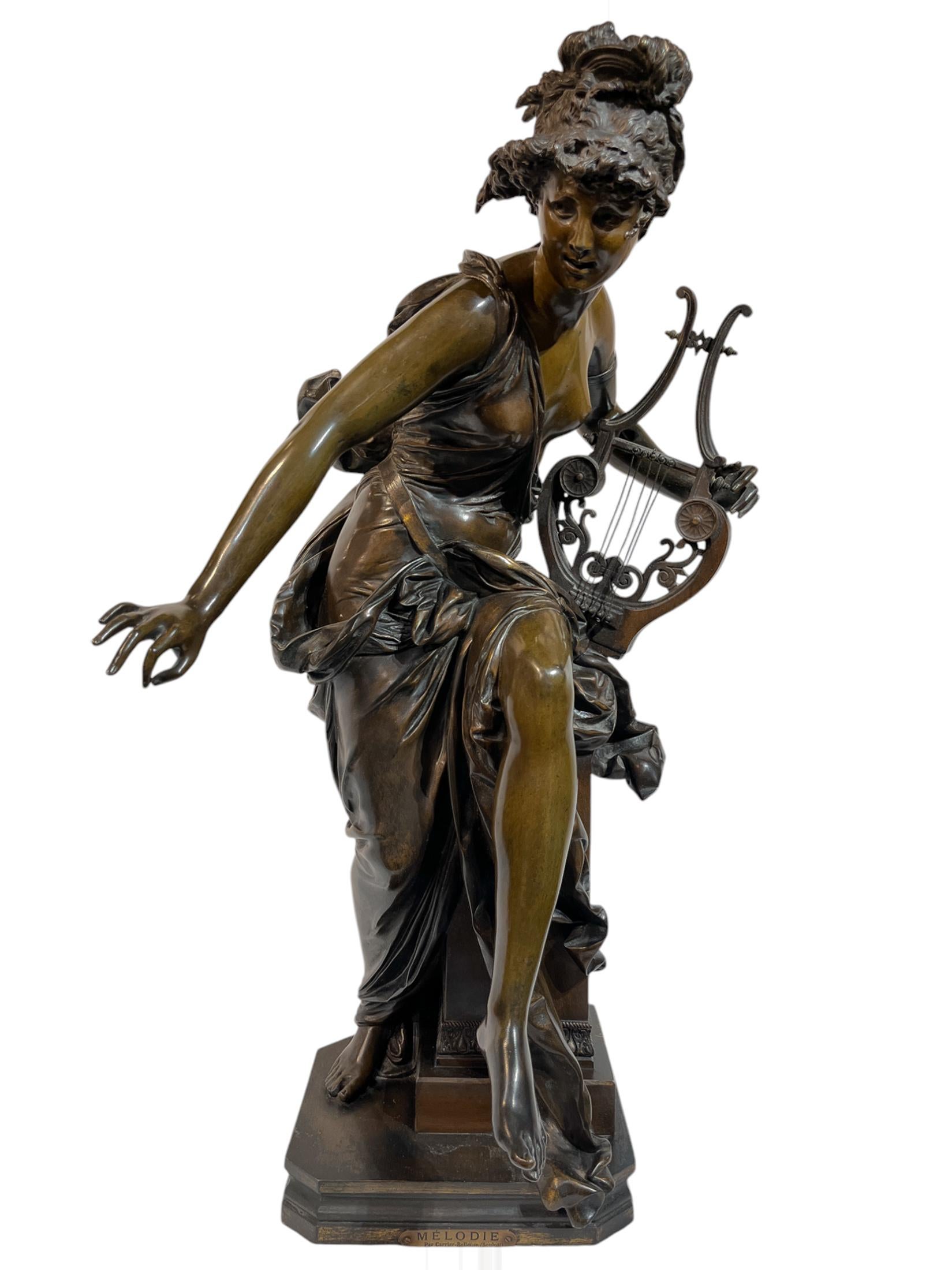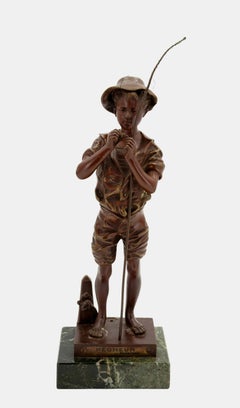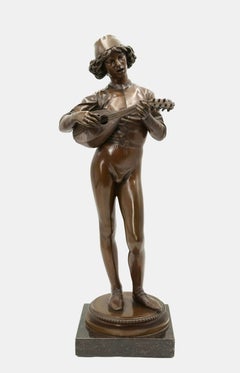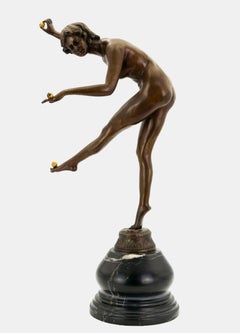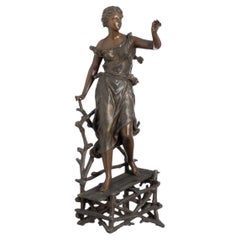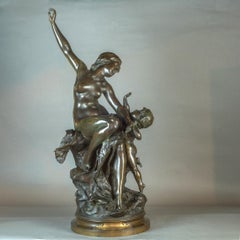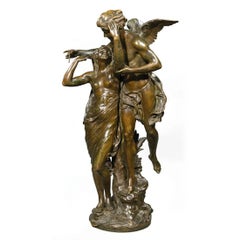Items Similar to Allegory of Progress / - The Driving Force of Inspiration -
Want more images or videos?
Request additional images or videos from the seller
1 of 8
Ernest RancouletAllegory of Progress / - The Driving Force of Inspiration -c. 1890
c. 1890
$648.70
$810.8720% Off
£485.22
£606.5320% Off
€544
€68020% Off
CA$896.23
CA$1,120.2920% Off
A$977.24
A$1,221.5620% Off
CHF 518.61
CHF 648.2720% Off
MX$11,814.57
MX$14,768.2120% Off
NOK 6,563.43
NOK 8,204.2920% Off
SEK 6,016.30
SEK 7,520.3820% Off
DKK 4,144.38
DKK 5,180.4820% Off
About the Item
Ernest Rancoulet (1842-1918), Allegory of Progress, around 1890. Bronze-plated metal cast with cast terrain plinth mounted on a wooden base (6 cm high). 64.5 cm (total height) x 28 cm (width) x 18 cm (depth), weight 7.2 kg. The male genius holds a leaf with the inscription “Les écrits”, the female genius holds the inscription “L'enseignement anime la jeunesse aux nouvelles découvertes”. On the plinth is a scroll with the words “Le Genie du Progres”. Signed “Rancoulet” on the reverse.
- Patina age-spotted, somewhat rubbed in places, rear border ring with defect, otherwise in good condition for its age.
- The Driving Force of Inspiration -
The upward-pointing hand of the male genius refers to the inspiration reflected in the writings, which is made clear by the words "Les écrits" on the sheet he is holding. He himself seems to have lowered himself onto the hill in order to descend to the earth, while the female genius stands with one foot on the circle of the earth and the other on the "ground of facts". The lines she wrote proclaim that from the "writings" mentioned by her companion comes the teaching that inspires youth to new discoveries. These discoveries are also reflected in writings, which in turn inspire the next generation. This cyclical progression is the "genius of progress" that the sculpture group represents. The female genius points to the word "nouvelles" with her writing instrument and anticipates the future with a joyful smile.
GERMAN VERSION
Ernest Rancoulet (1842-1918), Allegorie des Fortschritts, um 1890. Bronzierter Metallguss mit gegossener Terrainplinthe auf Holzsockel (6 cm Höhe) montiert. 64,5 cm (Gesamthöhe) x 28 cm (Breite) x 18 cm (Tiefe), Gewicht 7,2 kg. Der männliche Genius hält ein Blatt mit dem Schriftzug „Les écrits“, der weibliche Genius die Inschrift „L'enseignement anime la jeunesse aux nouvelles découvertes“. Auf der Plinthe liegt eine Schriftrolle mit den Worten „Le Genie du Progres“. Rückseitig mit „Rancoulet“ signiert.
- Patina altersfleckig, vereinzelt etwas berieben, hinterer Einfassungsring mit Fehlstelle, ansonsten in einem altersgemäß guten Zustand.
- Die vorantreibende Kraft der Inspiration -
Die nach oben gerichtete Hand des männlichen Genius verweist auf die Inspiration, die sich in den Schriften niederschlägt, was die Worte „Les écrits“ auf dem von ihm gehaltenen Blatt verdeutlichen. Er selbst scheint sich auf den Hügel hinabgelassen zu haben, um auf die Erde niederzusteigen, während der weibliche Genius mit einem Fuß auf dem Erdenkreis und mit dem anderen auf dem ‚Boden der Tatsachen‘ steht. Die von ihr verfassten Zeilen verkünden, dass aus den von ihrem Begleiter genannten ‚Schriften‘ die Lehre hervorgeht, welche die Jugend zu neuen Entdeckungen inspiriert. Diese Erkenntnisse schlagen sich ebenfalls in Schriften nieder, die wiederum die kommende Generation animiert. Dieses zyklische Voranschreiten ist der „Genius des Fortschritts“, den die Skulpturengruppe zur Darstellung bringt. Dabei deutet der weibliche Genius mit seinem Schreibgerät auf das Wort „nouvelles“ und nimmt mit seinem in die Ferne gerichteten Blick freudig lächelnd die Zukunft vorweg.

About the Seller
5.0
Vetted Professional Seller
Every seller passes strict standards for authenticity and reliability
Established in 2014
1stDibs seller since 2023
23 sales on 1stDibs
- ShippingRetrieving quote...Shipping from: Berlin, Germany
- Return Policy
More From This Seller
View AllPecheur / - Full of anticipation -
Located in Berlin, DE
Adolphe Jean Lavergne (1863-1928), Pecheur, c. 1900. Brown patinated bronze with rectangular cast plinth on a green marble base (3 cm high), total height with hinge 37 cm, width 9 cm, depth 8 cm, weight 2.9 kg, signed “Lavergne” on the plinth.
- Base with old drilling and a few oxidized areas, patina occasionally rubbed, somewhat stained in the folds.
- Full of anticipation -
This bronze is the larger, highly detailed version of the fisherman that made Parisian artist Adolphe Jean Lavergne famous. In preparation for fishing, the boy prepares his rod before heading out to sea. The attachment of the iron ring and the rope behind him suggest a quay wall and a boat moored there. However, the depiction is entirely focused on the actual action of the young fisherman: With equal skill and concentration, he bends a hook to connect it to the fishing line. The contrast with his casual clothing, the loose-fitting trousers, the open shirt with its "wild" folds, and, last but not least, the sun hat boldly perched on his neck, reinforces the impression of the attentive care with which he goes about his work. His gaze makes him appear absorbed, as if he has forgotten the world around him and yet he is visibly filled with anticipation of fishing.
GERMAN VERSION
Adolphe Jean Lavergne (1863-1928), Pecheur, um 1890. Braun patinierte Bronze mit rechteckiger gegossener Plinthe auf grünem Marmorsockel (3 cm Höhe), Gesamthöhe mit Angel 37 cm, Breite 9 cm, Tiefe 8 cm, Gewicht 2,9 kg, auf der Plinthe mit „Lavergne“ signiert.
- Sockel mit alter Bohrung und wenigen oxidierten Stellen, Patina mitunter berieben, in den Falten vereinzelt etwas fleckig.
- Voller Vorfreude -
Die Bronzefigur ist die größere äußerst detaillierte Ausführung des Fischers, mit dem der Pariser Künstler Adolphe Jean Lavergne bekannt geworden ist. In Vorbereitung auf das Fischen präpariert der Junge die Angel...
Category
1890s Realist Figurative Sculptures
Materials
Bronze
$686 Sale Price
20% Off
Florentine singer / - The Renaissance of the Renaissance -
By Paul Dubois
Located in Berlin, DE
Paul Dubois (1829 Nogent-sur-Seine - 1905 Paris), Florentine singer, 1865. Light brown patinated bronze with cast round plinth mounted on a square marble base (3.5 cm high). Total height 53 cm. Bronze dimensions: 49.5 cm (height) x 20 cm (length) x 10 cm (width), weight 5.6 kg. Inscribed on the plinth "P.[aul] DUBOIS", dated "1865", with the foundry's mark "F. BARBEDIENNE FONDEUR" and the signet "REDUCTION MECANIQUE A. COLLAS".
- Patina very occasionally darkened, lute with loss of one tuning peg, otherwise in excellent condition.
- The renaissance of the Renaissance -
The bronze is a precisely executed and masterfully cast contemporary reduction of Paul Dubois 155 cm tall masterpiece "Florentine Singer", which is exhibited in the Musée d'Orsay and for which the artist was awarded the Medal of Honor at the Paris Salon in 1865. The work acted as a beacon, and was followed by a plethora of depictions of juveniles.
Inspired by Donatello and Luca della Robbia, but also by painters such as Piero della Francesca, Benozzo Gozzoli, and Pinturicchio, the "Florentine Singer" is not an epigonal work that pays homage to a vanished era, but a successful attempt to draw vitality from the art of the past and thus give it new life.
The effect of vitality is the core of Italian Renaissance art theory. In order to fulfill itself as art, art had to appear like nature. This naturalism also characterizes the "Florentine Singer". The young man appears to have been taken from life, which is reinforced by the momentary nature of his action. He has just struck a now fading chord. In addition, the natural appearance is enhanced by the detailed shaping of the figurative details, such as the laces with the slightly curved leather of the shoes, the belt buckle, or the ornamentation on the body of the lute. Even the fingernails are clearly defined. Unlike the Renaissance, however, the effect of liveliness here is not based on the "discovery" of nature and the human body, but primarily on the rediscovery of the art of the Quattrocento. The liveliness of the artwork is therefore at the same time a revitalization of this art, so that we can speak of a Renaissance of the Renaissance, just as the Pre-Raphaelites in England at the same time transferred the Quattrocento to contemporary art.
Dubois takes on the most difficult of all subjects, the depiction of singing through silent sculpture. He was preceded in this by Luca della Robbia and Donatello with their pulpits of singers created in the 1430s in the Museo dell'Opera del Duomo in Florence. Compared to these works, the physiognomy of Dubois singer is far less animated, yet he also depicts singing in a convincing manner. He uses the whole body. He takes the ancient contrapposto, which was essential to Renaissance sculpture, and transforms the standing leg-playing posture into a late medieval S-swing, giving the body an elegant beauty and at the same time setting it in melodic motion. In the equally elegant finger position, the music is expressed in a much more literal way with the beating of the lute. Finally, the musicality of the sculpture culminates in the face with the mouth open to sing.
Through the act of singing, which is a great challenge to the artistic will to depict perfect beauty, the gracefulness of the classical face is not diminished, but enhanced. Starting from the face with the singing mouth and the gaze absorbed by the sounds, the inner vitality spreads, giving the bronze sculpture an intense aura, enhanced by the music. Dubois transfers the beauty of the Renaissance to the musical, sublimating the visible sculpture to the invisible of music.
He took up the challenge of transcending the Renaissance with the Renaissance, thus responding to the Querelle des Anciens et des Modernes, which arose at the end of the 17th century around the French Academy and remained virulent into the 19th century, in which antiquity was regarded either as an unattainable ideal or as a standard to be surpassed. With his work, Dubois proved that the Renaissance, which had championed the art of the ancients, could lead to a new renaissance of art.
About the artist
Paul Dubois' great-uncle was the famous French Baroque sculptor Jean-Baptiste Pigalle, in whose footsteps the talented great-nephew followed. When he debuted at the Paris Salon in 1858, he signed his work "Dubois-Pigalle". At his father's request, however, he first studied law before devoting himself to sculpture under the tutelage of François Christophe Armand Toussaint in 1856 and entering the École des Beaux-Arts in 1858. From 1859 to 1863, he lived in Rome and traveled to Naples and Florence. Inspired by Florentine art of the quattrocento, Dubois initiated a school-forming neo-Florentine style that combined the elegantly simple forms of youthful grace with a precise wealth of detail.Two purchases by the French state (“envois de Rome”) were made during his stay in Rome, which brought him recognition in Paris. After his return there, he quickly became an internationally sought-after artist.
Dubois was also active as a creator of monuments. His most famous work is the equestrian statue of Joan of Arc (1896) on the forecourt of Reims Cathedral. He was also a sought-after portraitist who produced around 50 busts and - Dubois was also a passionate painter - around 100 portraits in oil.
From 1873 to 1878 he was curator of the Museum du Luxembourg, in 1876 he became a member of the Institut de France and from 1878 to 1905 he was director of the École des Beaux-Arts.
In 1865, Dubois was awarded the Paris Salon Medal of Honor for his “Florentine Singer”. In 1867 he became Chevalier, in 1874 Officier, in 1886 Commandeur of the Légion d'honneur, which awarded Dubois the Grande Croix in 1896.
Selected Bibliography
Stole, Elmar: Paul Dubois. In: Saur. Allgemeines Künstlerlexikon, vol. 30, Munich - Leipzig 2001, pp. 677-678.
GERMAN VERSION
Paul Dubois (1829 Nogent-sur-Seine - 1905 Paris), Florentinischer Sänger, 1865. Hellbraun patinierte Bronze mit gegossener runder Plinthe auf quadratischem Marmorsockel montiert (3,5 cm Höhe). Gesamthöhe 53 cm. Maße der Bronze: 49,5 cm (Höhe) x 20 cm (Länge) x 10 cm (Breite), Gewicht 5,6 kg. Auf der Plinthe mit „P.[aul] DUBOIS“ bezeichnet, auf „1865“ datiert, mit dem Gießereistempel „F. BARBEDIENNE FONDEUR“ und dem Signet „REDUCTION MECANIQUE A. COLLAS“ versehen.
- Patina sehr vereinzelt nachgedunkelt, Laute mit Verlust eines Stimmwirbels, ansonsten ausgezeichnet erhalten.
- Die Renaissance...
Category
1860s Realist Figurative Sculptures
Materials
Bronze
$4,292 Sale Price
20% Off
The Victorious David / - The melancholy of the radiant hero -
Located in Berlin, DE
Henri Honoré Plé (1853 Paris - 1922 Paris), The Victorious David, around1890. Red-brown and brown patinated bronze with terrain plinth mounted on a round base. 42 cm (total height) x...
Category
1890s Realist Figurative Sculptures
Materials
Bronze
$1,812 Sale Price
20% Off
Juggler / - Artistic naturalness -
Located in Berlin, DE
Claire Jeanne Robertine Colinet (1880 Brussels - 1950 Asnières-sur-Seine), Juggler, around 1920. Brownish patinated bronze with gilded balls on a round, multi-profiled stone base (10...
Category
1920s Art Deco Nude Sculptures
Materials
Bronze
$2,766 Sale Price
20% Off
Mother Happiness / - The ecstasy of maternal joy -
Located in Berlin, DE
Johannes Boese (1856 Ostrog - 1917 Berlin), Mutterglück, um 1910. Goldbraun patinierte Bronze auf gegossener rechteckiger Plinthe, montiert auf zweifarbigem Marmorsockel (9,5 cm Höhe...
Category
1910s Art Nouveau Nude Sculptures
Materials
Bronze
The Victorious David / - The melancholy of the radiant hero -
Located in Berlin, DE
Henri Honoré Plé (1853 Paris - 1922 Paris), The Victorious David, around 1890. Red-brown and brown patinated bronze with terrain plinth mounted on a round base. 62 cm (total height) ...
Category
1890s Realist Figurative Sculptures
Materials
Bronze
$4,006 Sale Price
20% Off
You May Also Like
Ernest Rancoulet (1842-1918)
By Rancoulet
Located in Porto, PT
"Myosotis". Bronze art sculpture. Height: 54 cm
Category
Antique 19th Century French Figurative Sculptures
Materials
Bronze
French Art Nouveau Bronze
Located in Berlin, DE
Bronze
72 cm
signed
Height: 72 cm.
Base diameter: approx. 22 cm.
Signed "E. Drouot". Stamped "BD Fondeur, Paris". Plaque engraved "Hebe Par Drouot (Hors Concours)".
Bronze, cast, ...
Category
Late 19th Century Art Nouveau Figurative Sculptures
Materials
Bronze
French Bronze Sculpture Statue by Alexandre Dercheu
Located in New York, NY
JULES-ALFRED-ALEXANDRE DERCHEU
French, (1864-1912)
L'Amour Désarmé
A nude girl holding Cupid away with her left arm, her left foot on his quiver, on a circular base, seated on a ro...
Category
1890s Figurative Sculptures
Materials
Bronze
Fine Bronze Figures Entitled "Reveil de la Nature" by E. Picaul
Located in New York, NY
Signed 'E. Picault' inscribed and titled ‘Reveil de la Nature’ on self-base
Artist: Emile Louis Picault (1833–1915)
Origin: French
Date: Late 19th century
Dimension: 34 1/2 x 17 inc...
Category
19th Century Figurative Sculptures
Materials
Bronze
The Song
By Félix Charpentier
Located in PARIS, FR
"The Song" by Félix Charpentier (1858-1924)
A very fine bronze sculpture with nuanced dark brown patina
Signed "Fx. Charpentier"
Cast by "E. Colin & Cie Paris"
France
around 1900
he...
Category
Early 1900s Art Nouveau Figurative Sculptures
Materials
Bronze
Albert Ernest Carrier-Belleuse A Figural Bronze Sculpture Melodie
By Albert-Ernest Carrier-Belleuse
Located in New York, NY
Albert-Ernest Carrier-Belleuse (1824 - 1887)
Female Figural Bronze Sculpture Melodie (Melody)
A young lady with a lyre in bronze with a dark green patina
19th Century
31" H x ...
Category
19th Century Figurative Sculptures
Materials
Bronze
More Ways To Browse
Antique Writing Instruments
Rancoulet Ernest
Philip Mccracken
Picasso Ceramic Goat Plate
Posset Pot
R C Gorman Pottery
Ramirez Manuel
Rene Coutelle
Rennert Inner Dialogue
Resin Gummy Bear
Ricardo Mesa
Richard Macdonald Orpheus
Richard Macdonald Red Dress
Richard Macdonald Trumpeter Draped
Richard Orpheo
Riho Kuld
Rodin Man With Broken Nose
Rolling Ball Sculpture
